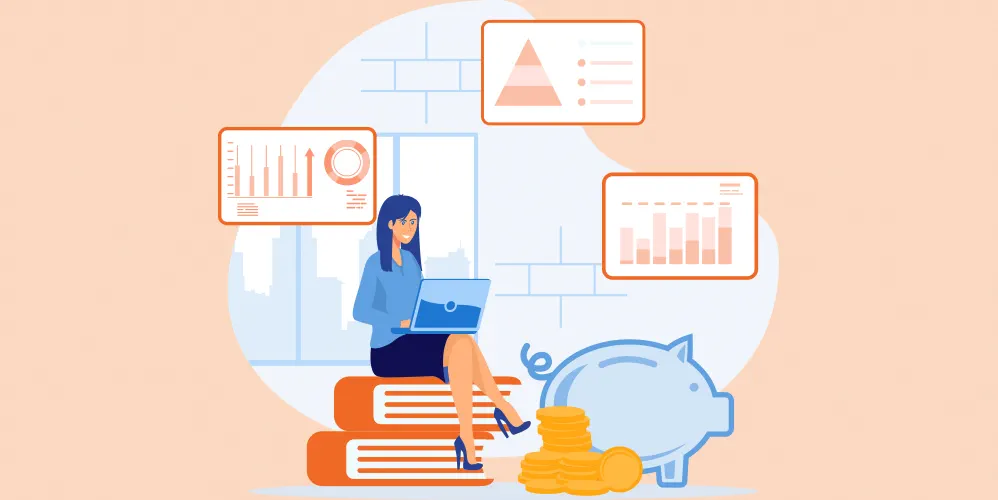
Types of Bank Accounts & Deposits in India
03 Jul 2019

What are the types of accounts and deposits available?
It’s important to know where you can save your money. As the rule goes, high-risk on your capital can result in a higher return while investing money in low-risk instruments would result in lower interest.
Banks, including Bank of Baroda offer a host of instruments that are what can be termed as low on risk and medium to low on return.
We shall now look at the various instruments that are available to a customer to deposit their money with the bank and earn returns.
Types of Deposits
A primary function for a bank is to mobilise public money. They do so in the form of deposits. There are two types of deposit accounts that you can open in a bank. They are time deposits and demand deposits.
Time Deposits
A Time Deposit also known as a Term Deposit is a deposit which has a fixed tenure and earns interest for the customer. The tenure varies for each instrument and may even change from bank to bank.
The most widely used name for time deposits is Fixed Deposits. The common feature among all Time deposits is that they cannot be withdrawn prematurely. One should thus plan their deposits according to their requirement for money going forward.
The more the money resides in the bank of a term deposit the more interest it earns. Banks pay higher interest in longer-term deposits than on shorter ones.
Fixed Deposits earn higher interest than a Savings Account because the former gives Banks leg room to lend to people who need the money for roughly the same time limit. For example, a one year fixed deposit in a bank can allow the bank to lend money to a person who requires a personal loan for one year period.
Commercial banks have over the years made Fixed Deposits more attractive by offering various frills like overdraft facility, zero cost credit cards, nomination facility, safe deposit lockers, internet banking among others.
Recurring Deposits
In this case, a fixed amount, as decided by the depositor, is deposited at regular intervals till the end of the tenure. The accumulated interest and the principal is given back to the depositor at the end of the tenure. The tenure of a recurring deposit can be anything from six months to 120 months.
Demand Deposits
As the name suggested, you can withdraw this deposit on demand. Such funds are held in accounts where it is easier to withdraw money either by going to the bank or an ATM. Savings and Current accounts are the two types of commonly used Demand Deposits account,
In such type of deposits, the risk is low but so is the return. However, there is one more factor that this type of deposit has and that is liquidity since money can be withdrawn at a moment’s notice.
The reason for the existence of such accounts is to provide the customer convenience of meeting his daily requirement of funds. It does not serve the purpose of ‘investment’ or ‘wealth creation’.
TYPES OF ACCOUNTS
Savings Account
These are interest-bearing accounts where the rate of interest depends on the bank where it is deposited. Further, there are restrictions in terms of the number of times money can be withdrawn from this account. These restrictions are also imposed by the bank and may vary between two banks. The depositor can withdraw his money by going to the bank and use the withdrawal slip or use his cheque book or go to an ATM and use his card. Money can also be transferred to someone else by using the cheque facility or using an electronic mode of transfer.
Current Account
This type of account is generally operated by companies and firms. These are the non-interest-bearing deposit and serve the purpose of providing liquidity. Since there are many transactions in these accounts, the cost of managing them is high. Hence banks ask the depositors to maintain a minimum deposit. Current accounts have overdraft facility which the banks provide the customers to meet their short-term liquidity mismatch.
Popular Articles
Related Articles









What Is Joint Account? - Meaning, Benefits, Application Process & How its Work

-
Disclaimer
The contents of this article/infographic/picture/video are meant solely for information purposes and do not necessarily reflect the views of Bank of Baroda. The contents are generic in nature and for informational purposes only. It is not a substitute for specific advice in your own circumstances. Bank of Baroda and/ or its Affiliates and its subsidiaries make no representation as to the accuracy; completeness or reliability of any information contained herein or otherwise provided and hereby disclaim any liability with regard to the same. The information is subject to updation, completion, revision, verification and amendment and the same may change materially. The information is not intended for distribution or use by any person in any jurisdiction where such distribution or use would be contrary to law or regulation or would subject Bank of Baroda or its affiliates to any licensing or registration requirements. Bank of Baroda shall not be responsible for any direct/indirect loss or liability incurred by the reader for taking any financial decisions based on the contents and information mentioned. Please consult your financial advisor before making any financial decision.
Saving accounts features
What are the features of a savings account?
A savings account is the first step a person takes toward saving. As the name suggests it is a place where the savings are stored but it is not an investment.
The savings account is the conduit through which investments can be made. But the first step starts from taking the money out of your money box and into a bank.
Why have a savings account?
Rather than keeping money at home in your money box, keeping it in a bank is suitable as it offers interest on the deposit made. This is the main reason why you have a savings account. The interest rate is not high, but it helps in partially softening the blow of inflation. In other words, the money one deposits in the bank are working to give you some return. Not only is the money in the savings account safe and earns interest it has other advantages also.
Features of a savings account
The following are the features of savings account
First, the money can be withdrawn at any point in time. With ‘Any-Time-Money’ (ATM) counters available across the country, a saving bank account holder who has debit/ ATM card facility can withdraw money from anywhere in the country. This adds a safety element where the depositor need not move around carrying cash in his pocket.
With e-payment on the increase, the saving bank account helps in regular monthly payments like that of electricity, society maintenance, telephone and mobile bill payment, insurance premium payment among others.
Salaries can be directly credited to the savings bank account. This helps both the employee as well as the employer. For the employer with a single click of the button, money is transferred to all the employees. For the employee, they are saved the travel to the bank as well as can have the money credited in their account at a faster pace.
Post-retirement the same savings bank account helps in getting a regular pension.
Loans that a person takes are generally linked to the savings bank account which is the primary account where his salary is deposited. Direct electronic instructions can be given from the savings bank account or Post Dated Cheques (PDCs) from this account. Savings bank account often eases the process of availing loans.
Cheque bounce history of the customer’s savings account tells his creditworthiness. A customer with no defaults on loans on his name has a much higher credit rating and finds it easier to get loans.
Having a savings bank account encourages the habit of saving rather than keeping cash in hand. This discourages impulsive shopping.
Savings account helps in accessing other financial instruments like online trading, mutual funds investments through direct transfers among others.
A standing instruction can be given to the bank where if the amount in the Savings Account crosses a particular threshold it will be transferred to any other higher yielding instrument.
It helps in making travel plans easier by booking tickets as well as hotel bookings through online mode.
The passbook or electronic statement of the savings bank helps in keeping an automatic tab of where the money came from and where it was spent.
At the end of the year, it helps in filling your tax returns with the income tax authorities. Since all the transactions are recorded in the bank statement, a salaried employee has the little hassle to file his returns.
What is current account
Banks offers several kinds of accounts to customers depending on their needs. Two of the most popular are savings account and current account.

